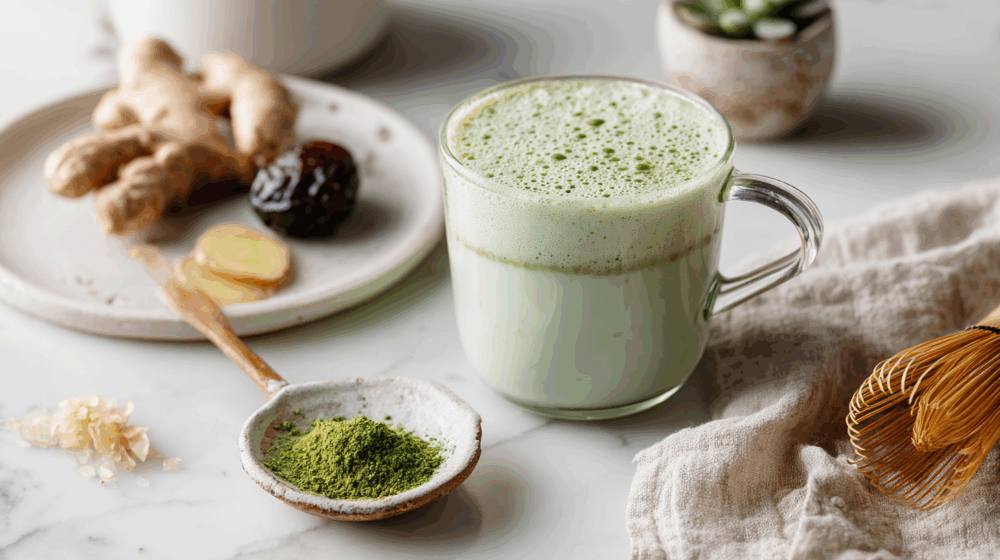
Ingredients
- 1 teaspoon high-quality matcha green tea powder
- 1 umeboshi plum or 1 teaspoon umeboshi paste
- 1 teaspoon freshly grated ginger root
- 1 piece kombu seaweed 2-inch strip
- 1 cup warm water 175°F/80°C
- 1 teaspoon raw honey optional, for sweetness
- Fresh lemon juice squeeze optional, for brightness
Instructions
- Place the kombu seaweed strip in a cup of warm water (175°F/80°C). Allow it to steep for 5 minutes to extract minerals and umami flavor. Remove the kombu strip and set the infused water aside.
- In a small mixing bowl, combine the matcha powder with 2 tablespoons of the warm kombu water. Using a bamboo whisk or small whisk, vigorously mix until the matcha becomes smooth and develops a light froth on top.
- Incorporate the freshly grated ginger and umeboshi plum (or umeboshi paste) into the matcha mixture. Stir thoroughly until all ingredients are well combined and the umeboshi is dissolved.
- Pour the matcha mixture into the remaining kombu-infused water. Add raw honey and a squeeze of fresh lemon juice if desired for additional flavor balance. Stir gently to combine all elements.
- Consume slowly on an empty stomach in the morning, or drink 20-30 minutes before meals. Sip mindfully to allow the body to absorb the beneficial compounds and support natural digestive processes.
I’ve been drinking this Japanese Mounjaro wellness blend for the past three months, and it’s completely transformed my morning routine. What started as curiosity about traditional Japanese health practices has become an essential part of how I begin each day, and I want to share why this ancient-meets-modern approach has worked so well for me.
The recipe itself feels like a meditation in preparation. Each morning, I take those few quiet minutes to steep the kombu, whisk the matcha into that perfect jade-green foam, and grate fresh ginger that fills my kitchen with its warming scent. There’s something deeply satisfying about this ritual that goes beyond just making a drink—it’s become my moment of intention-setting before the day begins.
What initially drew me to this particular combination was learning about the individual powerhouses hiding in each ingredient. Matcha, that vibrant green powder that’s been central to Japanese tea ceremonies for centuries, contains catechins like EGCG that research suggests can support fat oxidation and metabolic function. But unlike the jittery energy I used to get from my morning coffee, matcha provides this steady, sustained alertness thanks to an amino acid called L-theanine. I don’t crash at 2 PM anymore, and my energy feels more even throughout the day.
The umeboshi plum was completely new to me when I first tried this recipe. These pickled, fermented plums have this incredible sour-salty complexity that wakes up your taste buds immediately. Beyond flavor, umeboshi brings probiotics to support digestive health—something I’ve definitely noticed in terms of reduced bloating and more comfortable digestion overall. Traditional Japanese medicine has used umeboshi for centuries to support stomach health and energy, and now I understand why.
Ginger needs no introduction as a digestive aid, but I was surprised by how much the fresh root elevates this drink. The warmth it provides isn’t just about temperature—there’s this internal warming sensation that seems to kickstart my metabolism. Research points to ginger’s thermogenic properties, meaning it can slightly increase calorie burning, but for me, it’s more about how it makes my whole digestive system feel activated and ready for the day.
The kombu seaweed initially seemed like the most unusual ingredient, but it’s become one of my favorites. This mineral-rich sea vegetable infuses the water with natural umami depth and provides iodine to support healthy thyroid function. Since thyroid health is crucial for metabolic regulation, this felt like a smart addition. The kombu also creates this subtle oceanic backdrop that makes the whole drink taste more complex and satisfying than you’d expect from such simple ingredients.
What I love most about this drink is how it fits into the Japanese philosophy of eating until you’re 80% full—hara hachi bu. When I sip this slowly before breakfast, I naturally feel more in tune with my hunger cues throughout the day. It’s not about appetite suppression in the harsh sense; it’s more like my body becomes better at communicating when it’s genuinely satisfied versus when I’m eating out of habit or stress.
The preparation method matters more than I initially thought. Using water that’s warm but not boiling preserves the delicate compounds in both the matcha and umeboshi. I learned this the hard way after a few attempts with water that was too hot resulted in bitter, harsh-tasting drinks. Now I use a thermometer to get that perfect 175°F temperature, and the difference in flavor is remarkable.
I’ve also discovered that the quality of ingredients makes a significant impact. Ceremonial-grade matcha costs more than culinary grade, but the smoother, less bitter flavor is worth every penny when you’re drinking it daily. Similarly, finding authentic umeboshi plums from a Japanese market versus the paste versions creates a more traditional taste experience, though both work effectively.
The timing of when I drink this has been crucial to its effectiveness. On an empty stomach first thing in the morning, I can actually feel my digestive system awakening. The combination seems to stimulate natural digestive enzymes, and I’ve noticed that my breakfast feels more satisfying and sits better in my stomach. When I occasionally have it before lunch or dinner, it helps me eat more mindfully and stop when I’m comfortably full rather than overstuffed.
One unexpected benefit has been how this drink affects my relationship with food throughout the day. The ritual of preparing it mindfully seems to carry over into how I approach all my meals. I find myself eating more slowly, paying attention to flavors and textures, and generally feeling more connected to the nourishment I’m providing my body.
The research behind these ingredients gives me confidence that I’m not just following a trend, but tapping into centuries of Japanese wellness wisdom backed by modern nutritional science. Studies on green tea catechins and weight management, research on ginger’s thermogenic effects, and the growing understanding of how gut health impacts overall wellbeing all support what Japanese culture has known for generations.
I’ve shared this recipe with friends who were initially skeptical about the unusual combination of flavors, but most have been surprised by how pleasant and energizing it tastes. The umami from the kombu and umeboshi creates this savory complexity that’s completely different from typical sweet morning drinks. It feels substantial and nourishing rather than like empty calories.
For anyone dealing with afternoon energy crashes, digestive discomfort, or just looking for a more mindful way to start the day, I can’t recommend this Japanese Mounjaro recipe highly enough. It’s not a magic solution, but as part of a balanced approach to nutrition and wellness, it’s become an invaluable tool in how I support my body’s natural processes.
The beauty of this traditional approach is that it doesn’t promise overnight transformation or unrealistic results. Instead, it offers a gentle, sustainable way to support your body’s natural metabolism, digestion, and energy production using ingredients that have been trusted for centuries. After three months of making this part of my routine, I can honestly say it’s one of the most beneficial changes I’ve made to my daily wellness practice.




